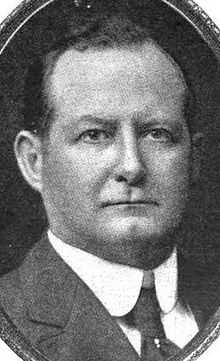John M. Slaton
| John Marshall Slaton | |
|---|---|
 | |
| 60th Governor of Georgia | |
| In office June 28, 1913 – June 26, 1915 | |
| Preceded by | Joseph M. Brown |
| Succeeded by | Nathaniel E. Harris |
| In office November 16, 1911 – January 25, 1912 | |
| Preceded by | M. Hoke Smith |
| Succeeded by | Joseph M. Brown |
| Personal details | |
| Born | December 25, 1866 Meriwether County, Georgia |
| Died | January 11, 1955 (aged 88) Atlanta, Georgia |
| Nationality | American |
| Political party | Democratic |
| Alma mater | University of Georgia |
John Marshall Slaton, or Jack Slaton, (December 25, 1866 – January 11, 1955) served two non-consecutive terms as the 60th Governor of Georgia. His political career was ended in 1915 by public outrage at his commuting of the death penalty awarded against Atlanta factory boss Leo Frank for the murder of a teenage girl employee. Slaton had judged the conviction unsafe, but his connections with Frank’s defense counsel led to accusations of undue interference.

Biography
Slaton was born in Meriwether County, Georgia.
Slaton received a master of arts degree with highest honors from the University of Georgia in 1886 where he joined Chi Phi Fraternity and the Phi Kappa Literary Society. Slaton married Sally Frances Grant in 1898.
Slaton's additional political service includes:
- Georgia House of Representatives, representing Fulton County (1896–1909)
- Speaker of the Georgia House (1905–1909)
- Georgia Senate, representing the 35th District (1909–1913)
- President of State Senate (1909–1911)
After Governor Hoke Smith was elected to the U.S. Senate in 1911, Slaton was appointed acting governor and served in that capacity from 1911 to 1912. Slaton was later elected to the governorship for a non-consecutive second term (1913 to 1915).
Leo Frank trial and the end of Slaton's political career
In 1915, Slaton commuted the sentence for Leo Frank from death to life imprisonment. "I can endure misconstruction, abuse and condemnation," Slaton said, "but I cannot stand the constant companionship of an accusing conscience which would remind me that I, as governor of Georgia, failed to do what I thought to be right.... It means that I must live in obscurity the rest of my days, but I would rather be plowing in a field than to feel that I had that blood on my hands."[1]
Because of the almost universal hostility towards Leo Frank by the general public in Georgia, Governor Slaton's decision to commute his death sentence was widely viewed as perverse interference. Public disapproval of Slaton persisted for a long time afterwards. Sparing Frank's life had the effect of permanently ending Slaton's political career, just as Slaton himself had predicted.
Controversy and conflict of interest in commutation of Leo Frank
Some viewed the commutation by Slaton as a conflict of interest, as Slaton was a law partner of Frank's lead defense counsel.[2] Slaton's actions led to threats of mob violence against the governor, and the Georgia National Guard and local police were enlisted for protection.[3][4][5]
Fear of retaliation prompted Slaton and his wife to move out of Georgia after his term as governor ended. They did not return to the state for a decade.[6]
After his public service, Slaton served as the President of the Georgia State Bar Association (1928–1929) and as a member of the General Council of the American Bar Association.[7]
The former governor died in Atlanta on January 11, 1955 and is interred with his wife Sarah Frances Grant (1870-1945) in the Grant family mausoleum at Atlanta's Oakland Cemetery.[8][9]
References
- ↑ "A Political Suicide". Time. January 24, 1955.
- ↑ Leonard Dinnerstein, The Leo Frank Case, 1999, page 124
- ↑ The Outlook magazine, A Courageous Governor, June 30, 1915, pages 492 to 493
- ↑ Catherine Cocks, Peter C. Holloran, Alan Lessoff, The A to Z of the Progressive Era, 2009, page 153
- ↑ George C. Kohn, The New Encyclopedia of American Scandal, 2001, page 146
- ↑ Kirby, Bill. (2010, May 15). A lawyer you want on your side. The Augusta Chronicle
- ↑ Matthew Bernstein, Screening a Lynching: The Leo Frank Case on Film and Television, 2009, page 143
- ↑ Ren Davis, Helen Davis, Timothy J. Crimmins, Atlanta's Oakland Cemetery: An Illustrated History and Guide, 2012, page 96
- ↑ Cathy Kaemmerlen, The Historic Oakland Cemetery, 2007, pages 107 to 108
External links
- Portrait of John Marshall Slaton
- The official and personal papers of John Marshall Slaton are housed at the Georgia Archives.
- Governor John M. Slaton: Executive Clemency Decision for Leo Frank, June 21, 1915
- John M. Slaton at Find a Grave
| Political offices | ||
|---|---|---|
| Preceded by Hoke Smith |
Governor of Georgia 1911 – 1912 |
Succeeded by Joseph M. Brown |
| Preceded by Joseph M. Brown |
Governor of Georgia 1913 – 1915 |
Succeeded by Nathaniel E. Harris |
| |||||||||||||
